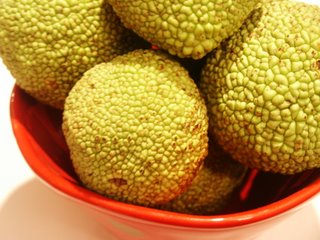
If you take a walk down Aiken’s Colleton Avenue this time of year, you might notice some strange looking fruit lying in the grass beneath a large tree. This tree and its green, bumpy, softball sized fruit are called Osage Orange.
I’m not sure why this green fruit is called an orange. It’s round like an orange and has a slightly citrus fragrance, and it has the thorny stems characteristic of true citrus. But it isn’t edible unless you’re a squirrel or a wooly mammoth and it is actually more closely related to the mulberry.
Though the Osage Orange is native to a small area in eastern Texas, Oklahoma and Arkansas, an area that was also home to the Osage Indians, it was introduced into other parts of America where it was planted extensively for fencerows. "Horse high, bull strong and hog tight" was the recommended size and shape for the Osage Orange fence. Its stiff, thorny, interlacing branches work like the barbed wire that eventually replaced it.
The Indians used the strong, elastic wood of the Osage Orange for making hunting bows and war clubs, and today some of the best bows are made of wood from the Osage Orange tree. Unverified stories claim that the fruit from this tree cut in half works as a bug repellent, and that the fruit kept around the base of you house keeps away cockroaches.
Several years ago Martha Stewart magazine ran an article suggesting cutting the fruit into half inch slices and letting it dry over a small ball of aluminum foil. The finished product looks like a little flower.
If you’ve a yen to plant an Osage Orange tree around your house, you might have a little trouble finding them available, though I did find one online source. If the fruit is what you’re after, remember that you need a male and a female tree to produce fruit.


